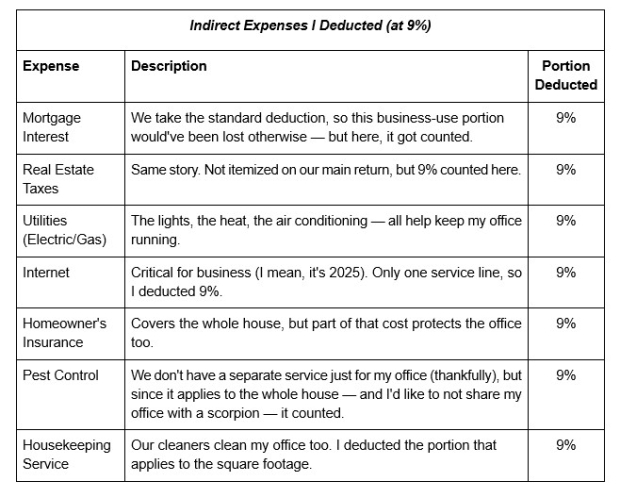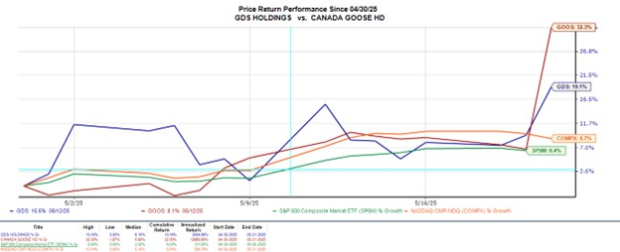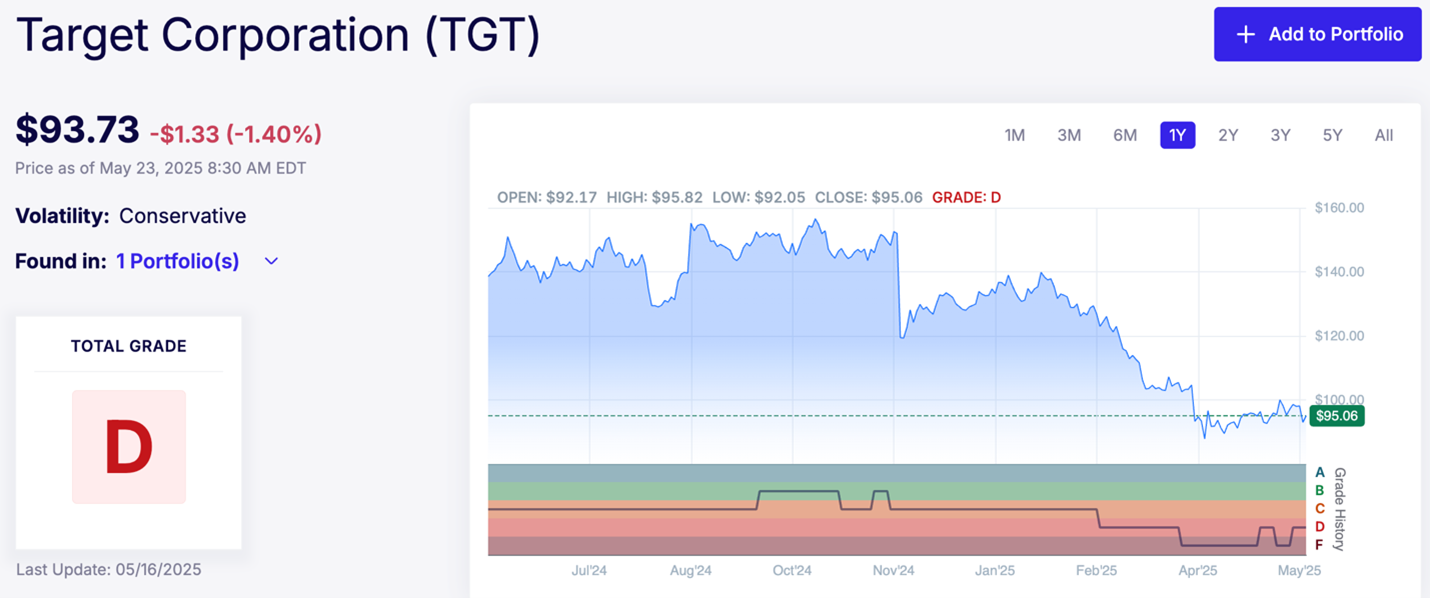Unlocking Home Office Tax Deductions: My Journey to Savings
There’s a profound sense of relief when you’re doing your taxes, and suddenly the number indicating what you owe flips to a refund. My husband and I experienced this firsthand. One moment, it showed we owed the IRS $500, and the next, we were greeted with a refund—a genuine surprise after years of no refunds in our household.
We sat there in disbelief, thinking, “Did that really just happen?” Indeed, it did, thanks to my home office.
For clarity, this wasn’t a dubious tax trick I stumbled upon; it was a legitimate deduction available to self-employed individuals who use part of their homes exclusively for business. Over the past few years, I had ventured into more freelance editing and writing, setting up an LLC to protect myself and experiment with personal finance.
I anticipated being able to write off the obvious business-related expenses, like software costs, my laptop, and perhaps a new desk chair. However, I was surprised to learn that I could also deduct a portion of my utilities, my internet bill, and even the expenses related to pest control and housekeeping for my workspace.
All of it.
These deductions combined to yield over a thousand dollars in tax savings.
This article reflects how my home office—where I manage invoices, write articles, and conduct Zoom calls with a plentiful supply of coffee mugs—became a significant tax win this year.
Since I value your time and want you to maximize any entitlement to savings, I felt it important to share what I learned. It was only upon delving into the specifics that I realized how beneficial this deduction could be. If my insights can help you, that’s an added bonus!
IRS Guidelines: Ensuring You Qualify for Home Office Deductions
It’s vital to understand upfront that the IRS has explicit guidelines for home office deductions. To qualify, you must satisfy two primary requirements:
Exclusive Use: The area of your home used for the deduction must be utilized solely for business purposes. Dual-use spaces, like a guest room that also serves as your workspace, will not qualify. You need a dedicated area specifically designated for work.
Regular Use: You must use the designated space regularly for your business—not just occasionally. This means that it should be your consistent work location.
The area doesn’t have to be a fully separate room but must clearly meet both criteria. If you have a specific nook where you regularly conduct your side business, that space might very well qualify.
Keep in mind, this deduction is exclusively available to self-employed individuals. Therefore, if you are a W-2 employee working from home, this deduction will not apply (a limitation I didn’t set, but perhaps a topic for legislative discussion). When I established my LLC, I only vaguely understood these concepts and had assumed the home office deduction was limited to those running comprehensive businesses from home, rather than someone like me conducting work occasionally from various spots around my home.
As I prepared our 2023 taxes—the first year my LLC was fully operational—I discovered the eligibility requirements for various self-employment deductions. It became clear that this deduction wasn’t exclusive to those with elaborate home offices but accessible to anyone operating a legitimate business willing to designate a workspace.
This realization spurred me to make some modifications. We had an under-utilized spare room downstairs, which I repurposed. This quiet space was the perfect size for a dedicated office. By 2024, I had a fully qualified home office and a newfound appreciation for how productive and tax-efficient such a space could be.
Transforming a Spare Room into a Tax Deduction
My home office occupies approximately 280 square feet, making up just over 9% of our entire house. As a result, I could deduct 9% of eligible household expenses, covering costs like electricity, internet, and homeowners insurance, as these expenses support my work environment.
The IRS offers two methods to calculate your deduction:
– The Simplified Method, which allows you to deduct $5 for each square foot (up to 300 square feet). In my case, for my 280-square-foot office, that would mean claiming a flat $1,400.
– The Regular Method, which I opted for. This method is more detailed, requiring you to fill out Form 8829. It enables you to deduct a percentage of actual expenses for utilities, insurance, repairs, pest control, and even depreciation on the house.
Notably, although we typically take the standard deduction on our taxes—thereby forgoing itemizing expenses like mortgage interest or real estate taxes—the home office deduction allows us to claim a portion of those expenses associated with my workspace, without itemizing on the main return.
The realization of that possibility took me a few readings. But yes—it is indeed allowed.
Deducting Common Household Costs: Electricity, Internet, and More
Before we delve deeper, let me clarify: I am not an accountant.
If you’re considering the home office deduction, I strongly recommend consulting a qualified tax professional. This article shares my experience and insights, not comprehensive financial advice.
Now let’s discuss deductions. If you use the Regular Method, you can divide specific home expenses between personal and business, depending on how much you occupy your home for work.
In my situation, that means approximately 9% of our home. My office comprises 280 square feet, which qualifies for a significant portion of expenses I was already paying.
Here’s how I categorized these expenses:
Fully Deductible “Direct” Expenses
These expenses pertain exclusively to your office. For instance, I installed blackout curtains to improve Zoom lighting. As these curtains are for my office only, their cost is fully deductible.
Additional fully deductible expenses include:
- Office-specific repairs (e.g., fixing a door, replacing carpet)
- Painting the office walls
- A separate business-only phone line
Partially Deductible “Indirect” Expenses
Indirect expenses are those that benefit the entire home but can have a portion deducted based on the business use. In my case, that applies to a percentage of shared household expenses.
Understanding the Benefits of the Home Office Deduction
The home office deduction can lead to significant savings for certain taxpayers. Specifically, it enables claimants to deduct a percentage—9% in this context—of various household expenses that support their business activities. Key expenses that fall under this category include:
- – Mortgage interest
- – Real estate taxes
- – Electricity and gas
- – Internet
- – Homeowner’s insurance
- – Pest control
- – Cleaning services
What makes this situation particularly interesting is that usual taxpayers who take the standard deduction do not itemize their mortgage interest or property taxes. However, when using the regular method for home office expenses, they are allowed to deduct a portion of these costs applied to their business use. This means deductions can effectively lower taxable income by recognizing previously neglected expenses that otherwise wouldn’t impact tax returns.
Additionally, since these deductions are categorized as business expenses rather than itemized deductions, they can also reduce the self-employment tax.
Analyzing My Deductions: Surprises and Insights
When I took the time to calculate my deductions, I was surprised by the speed with which the totals accumulated. A seemingly small percentage could lead to substantial savings when applied to significant recurring household expenses. Below is a breakdown of my deductions, calculated at a 9% business use rate:
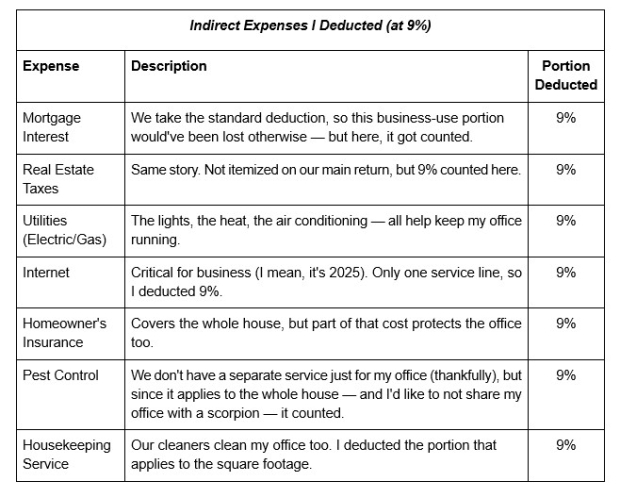
Image Source: Zacks Investment Research
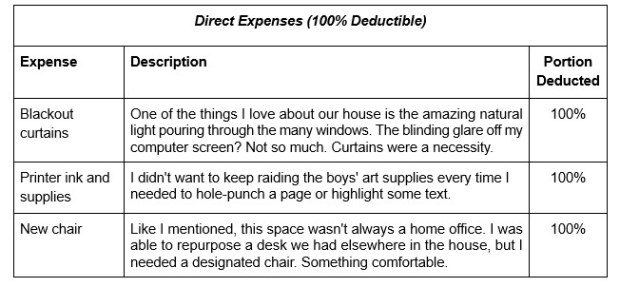
Image Source: Zacks Investment Research
Direct office expenses tended to be fewer. Nevertheless, any expense tied exclusively to the home office is fully deductible. Note that what I claimed may look quite different from another individual’s deductions, as each case is unique.
A critical distinction to recognize: if I had acquired a separate business insurance policy, that cost would not qualify for the home office deduction. Instead, it would be considered a fully deductible business expense on Schedule C. Consulting a tax professional could provide clarity in such situations.
Moreover, if you use your home office for only part of the year—say, starting freelance work in July—you can only deduct expenses for the months you used the office. The IRS does not permit claiming a full year of deductions for only a half-year’s worth of business activity. Timing is crucial.
Transforming My Tax Situation
After inputting my final batch of home office expenses, I was not anticipating any dramatic changes. My goal was just to reduce our tax bill by a few hundred dollars. The result, however, was a complete turnaround of our tax situation.
In a matter of moments, our looming $500 payment transformed into a refund. This wasn’t magic—it was simply careful mathematical calculations involving data entry that required diligence. The results were astonishing.
It became evident to me that this deduction extended beyond merely saving money on office supplies. It was also a recognition of the value of my business and my time.
The fact that I was already covering household costs like electricity and internet meant I could now leverage some of these unavoidable expenses to benefit my business finances.
After years of being a W-2 employee, this revelation felt particularly significant. I realized I was no longer just liable for taxes; I had the opportunity to operate within a different framework.
Assessing the Value of the Home Office Deduction
The pivotal question is whether the home office deduction merits the effort involved in claiming it. The answer depends on individual circumstances.
It may not be worth the effort if:
- – You are a W-2 employee working from home, as employees do not qualify for this deduction.
- – You occasionally manage tasks from a couch without a dedicated workspace.
- – Your workspace is also a multipurpose area, lacking the “exclusive and regular use” requirement defined by the IRS.
However, the deduction is likely beneficial if:
- – You are self-employed, freelancing, or running a business from home that is financially significant.
- – You have a designated space in your home used strictly for your work.
- – You already incur costs for internet, utilities, and insurance and seek tax-deductible business expenses.
- – You take the standard deduction on your taxes and would like to claim a deduction for mortgage interest and property taxes.
If any of this resonates with your situation, exploring the home office deduction could be worthwhile.
However, I am not a CPA, so this should not be taken as professional tax advice. It simply reflects a personal finance journey that saved me $1,000 unexpectedly. Even if you find the home office deduction inapplicable, I encourage asking informed questions and consulting with an accountant to understand tax code opportunities.
Tax deductions are not mere numbers on a form; they represent a way to ensure your financial resources and efforts are recognized adequately.
Maximize Your Financial Potential with Expert Guidance
Are you seeking practical tips and strategies to navigate the current economy? Subscribe to Zacks’ free Money Sense newsletter to access precise and actionable advice aimed at saving money, reducing taxes, and building a financial legacy.
From essential investment strategies to effective budgeting techniques, Money Sense can assist you in growing your wealth intelligently. Sign up today to pursue your financial goals at no cost.
Receive Money Sense for free >>
This article originally published on Zacks Investment Research (zacks.com).
The views and opinions expressed herein are the views and opinions of the author and do not necessarily reflect those of Nasdaq, Inc.
